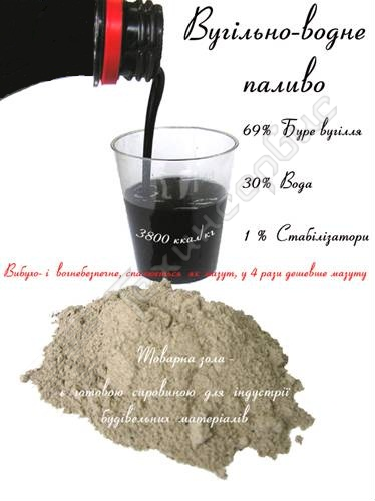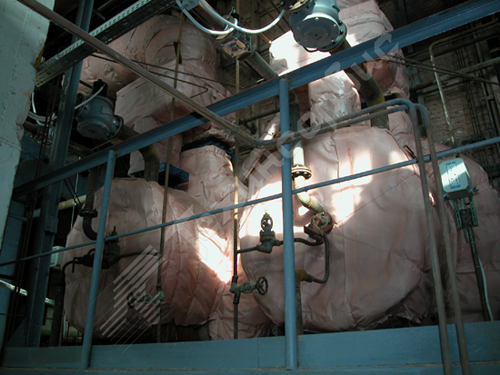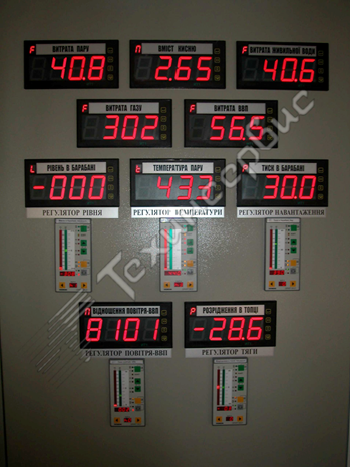Articles
Coal-water fuel is the way to energy independence
09.09.2014
_____________

Having analysed all the difficulties that arise when burning coal in pure form by conservative methods, Techinservice focused its attention on the development and improvement of the production technology and combustion of coal-water fuel.
The coal-water fuel (CWF) is a dispersed fuel system consisting of finely ground (100-300 (500) μm) coal, water (of any quality, including mine and industrial wastewater, as well as molasses alcohol distillery dregs) and a plasticizer reagent.
Such use of CWF has environmental, technological and economic advantages:
• safe at all stages of production, transportation and use;
• allows to reduce 1.5-3.5 times the harmful emissions to the atmosphere (dust, oxides of nitrogen, benzopyrene, sulfur dioxide) due to a lower temperature in the active combustion zone not exceeding 1,200 °C;
• allows efficient use of volatile fine ashes generated during combustion in the production of building materials.
- Technological:
• similar to liquid fuel (when converting heat-generating installations to CWF incineration it does not require significant changes in the design of the units);
• allows to fully mechanize and automate the processes of receiving, supply and combustion of fuel;
• new technology of vortex combustion at a temperature of 950-1,150 °С allows to achieve fuel efficiency over 97% (in case of layer burning of coal, this value does not exceed 70%);
• several ignition systems for coal-water fuel have been developed: using a plasma torch, natural gas, liquid and solid fuels.
• reduces the cost of 1 t (2 or more times);
• the technology does not require the use of thermal and chemical processes, and therefore it is not capital-intensive and energy-intensive;
• the ability to use coal of any brand (anthracite, stone, brown coal), which allows you to attract coal from local deposits, thereby reducing transportation costs;
• operating costs during storage, transportation and burning are reduced by 15-30%;
• due to the ease of CWF transportation, it is possible to construct a centralized complex for its preparation and to supply consumers with ready-made fuel;
• cost recovery when introducing CWF is 1-2.5 years (depending on the capacity of the boiler room and the number of hours of its operation per year).
 The technology of preparation and combustion of coal-water fuel, developed and implemented by Techinservice at the CHP of the sugar plant, includes the following steps:
The technology of preparation and combustion of coal-water fuel, developed and implemented by Techinservice at the CHP of the sugar plant, includes the following steps:
- supply and dosage of coal for grinding;
- preparation and dosage of the plasticizer reagent solution;
- homogenization;
- coarse CWF filtering;
- precise adjustment of the suspension density;
- delivery of the obtained product to storage in the storage tank, then to the buffer tank in the CHP;
- fine filtration;
- after heating CWF to saturation temperature;
- combustion in the boiler furnace, with adjustable flow and fuel-air ratio;
- • "wet" or "dry" ash collection.
To reduce the zone of active combustion and reduce the temperature at the outlet from the furnace of the boiler, Techinservice has developed and patented a muffle burner for earlier evaporation of the moisture of a coal-water emulsion. The CWF sprayed flow enters the area of the furnace with a high degree of axial recirculation of flue gases. In the muffle burner there are two stages of twisting and two stages of gas distribution for heating the muffle and maintaining the front of ignition, which makes it possible to adjust the load of the boiler.
The muffle burner provides the opportunity for combustion in the boiler of two types of fuel (gas and coal-water fuel), both separately and in combination.
 The processes of the CWF preparation and combustion are fully automated.
The processes of the CWF preparation and combustion are fully automated.
Combustion automation systems take into account the amount of harmful emissions, the characteristics of exhaust gases, etc. Based on the mentioned data the automatic control system regulates a fuel feed mode, boiler operation, etc. which ensures its optimum performance.
The hardware base is implemented on the equipment of the companies Siemens and Schneider. The used configuration consists of a programmable logic controller, input and output modules for analog and discrete signals, local controllers and frequency converters.
To increase reliability and robustness of the system, the controller has been replicated by local controllers, which carry out a "hot" pickup in the event of a shutdown of the controller and its failure.
The controller communicates with the operator’s workstation via Industrial Ethernet network. The unit is controlled by the operator from the workstation or with the help of the local control panel. To develop the operator interface, a software product WinCC system by Siemens SCADA was used.
System functions:
- controlling the gaseous fuel combustion process;
- controlling the coal water fuel combustion process;
- • adjusting a fuel-air ratio depending on the O2 level.

• control of the technological process;
• monitoring of process parameters;
• control and analysis of preset working procedures;
• data visualization and registration;
• generation of reports and summaries;
• data storage.
Optimal monitoring of the fuel-air ratio allows making the most of fuel value. This technology allows burning coal and getting additional energy due to the release of hydrogen from water during a chemical reaction of burning coal. Economic efficiency is achieved through the use of cheap fuel, its saving, reducing the number of personnel. Rapid troubleshooting helps reduce downtime, and therefore maintenance costs.
Of course, the future is in the renewable energy sources which will be used on an industrial scale. But this is a matter of the distant future, when the appropriate equipment will provide the necessary capacity and become affordable and cost-effective. But the power of coal has not yet exhausted its capabilities, and CWF can really become a serious competitive fuel for the coming decades.
________________________
Journal Sugar No. 4, 2008

